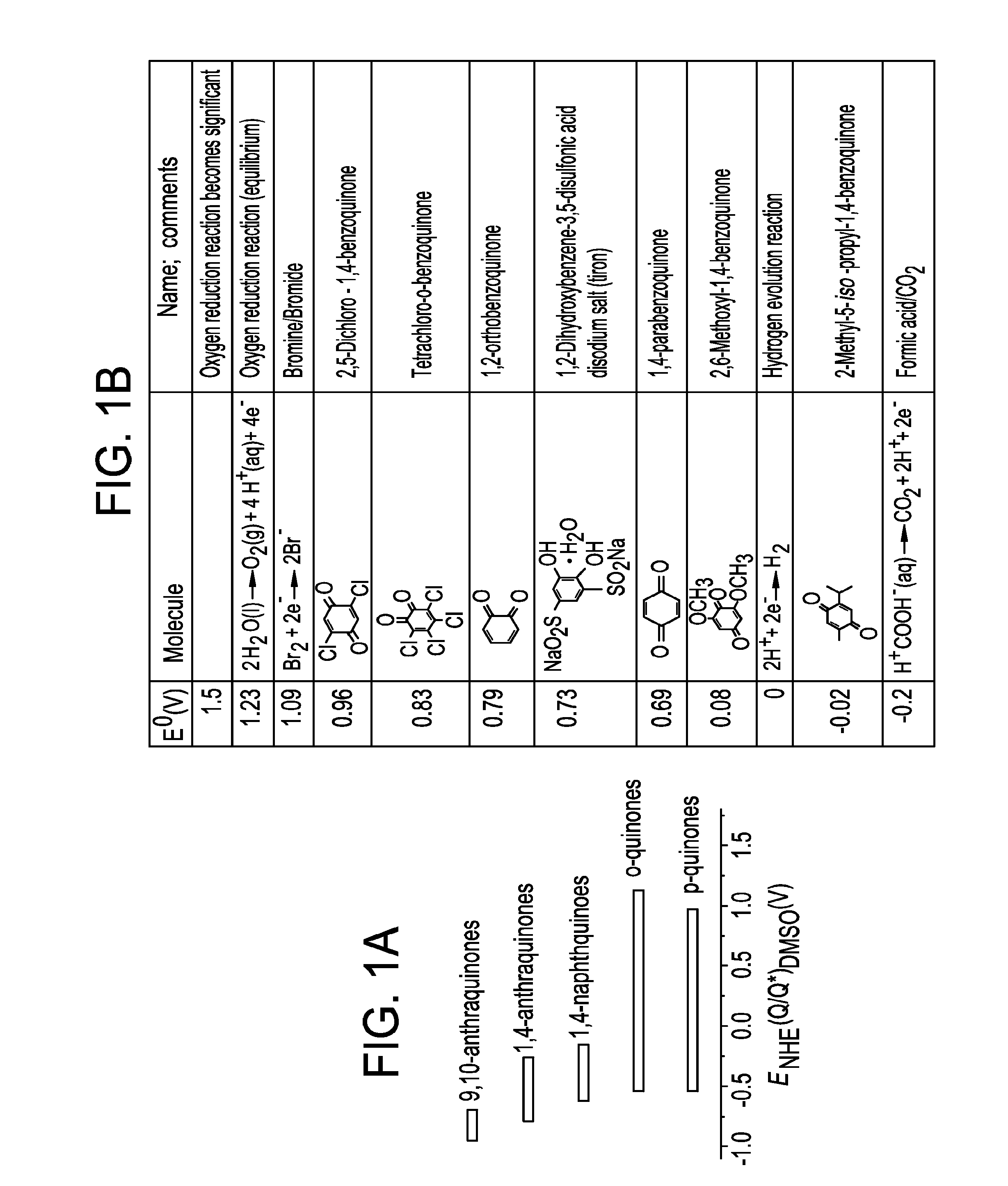Small organic molecule based flow battery
a flow battery, organic technology, applied in the direction of indirect fuel cells, cell components, electrochemical generators, etc., can solve the problems of compromising the effectiveness of electrodes, limiting the use in a manned environment, such as the home, and limiting the price at large scale. , to achieve the effect of high current density, high efficiency and large-scale energy storag
- Summary
- Abstract
- Description
- Claims
- Application Information
AI Technical Summary
Benefits of technology
Problems solved by technology
Method used
Image
Examples
example 1
[0088]1 molal 1,2-ortho-benzohydroquinone (catechol) was oxidized in 1 N H2SO4 at a flat Pt electrode, obtaining the cyclic voltammetry curves shown in FIG. 3A. The sweep starts at (0.2 V, 0 mA / cm2) and proceeds at 25 mV / s to the right. At about 600 mV vs. Ag / AgCl (the known E0 is 795 mV vs. SHE), the current density increases as catechol is oxidized to the orthoquinone form. The oxidative current density peaks at about 150 mA / cm2. The peak and downturn are caused by reactant depletion in a quiescent (non-flowing, non-stirred) electrolyte. In a test at a higher concentration of 3.9 molal (FIG. 3B), we observe asymmetric oxidation and reduction peaks, achieving current densities above 500 mA / cm2 for the former. The asymmetric shape of the curve in FIG. 3B arises because the quinone form is unstable in aqueous solution. In addition the limited solubility of ortho-benzoquinone (0.06 M) compared to its reduced form precludes symmetric behavior at high concentration.
example 2
[0089]The half-cell redox behavior of hydroquinone-2-sulfonic acid (HQSA) is shown in FIG. 4. At a pH of 7 a rise in current density was observed beginning near 0.5 V and peaking at higher voltage. Upon reversing the direction of the voltage sweep, negative current (indicating a reduction event) was observed near 0.3 V. The large difference between where the oxidation and reduction currents are observed indicates a chemical process was likely occurring. In this case, upon oxidation of HQSA to the quinone form, water reacted with the quinone to form a new species. This species was reduced at the lower 0.3 V potential. At a pH of 13, the reaction became rapid and reversible because in basic solution the —OH groups on HQSA became deprotonated. The positive and negative current density observed near 0 V was indicative of a 2-electron redox event with no protons having been exchanged.
example 3
[0090]AQDS was subjected to half-cell electrochemical measurements. Cyclic voltammetry of a 1 mM solution of AQDS in 1 M sulfuric acid on a glassy carbon disc working electrode showed current peaks corresponding to reduction and oxidation of the anthraquinone species (FIG. 5A). The peak separation of 34 mV was close to the 59 mV / n, where n was the number of electrons involved, expected for a two-electron process.
PUM
| Property | Measurement | Unit |
|---|---|---|
| current densities | aaaaa | aaaaa |
| standard electrochemical potential | aaaaa | aaaaa |
| current densities | aaaaa | aaaaa |
Abstract
Description
Claims
Application Information
 Login to View More
Login to View More - R&D
- Intellectual Property
- Life Sciences
- Materials
- Tech Scout
- Unparalleled Data Quality
- Higher Quality Content
- 60% Fewer Hallucinations
Browse by: Latest US Patents, China's latest patents, Technical Efficacy Thesaurus, Application Domain, Technology Topic, Popular Technical Reports.
© 2025 PatSnap. All rights reserved.Legal|Privacy policy|Modern Slavery Act Transparency Statement|Sitemap|About US| Contact US: help@patsnap.com



